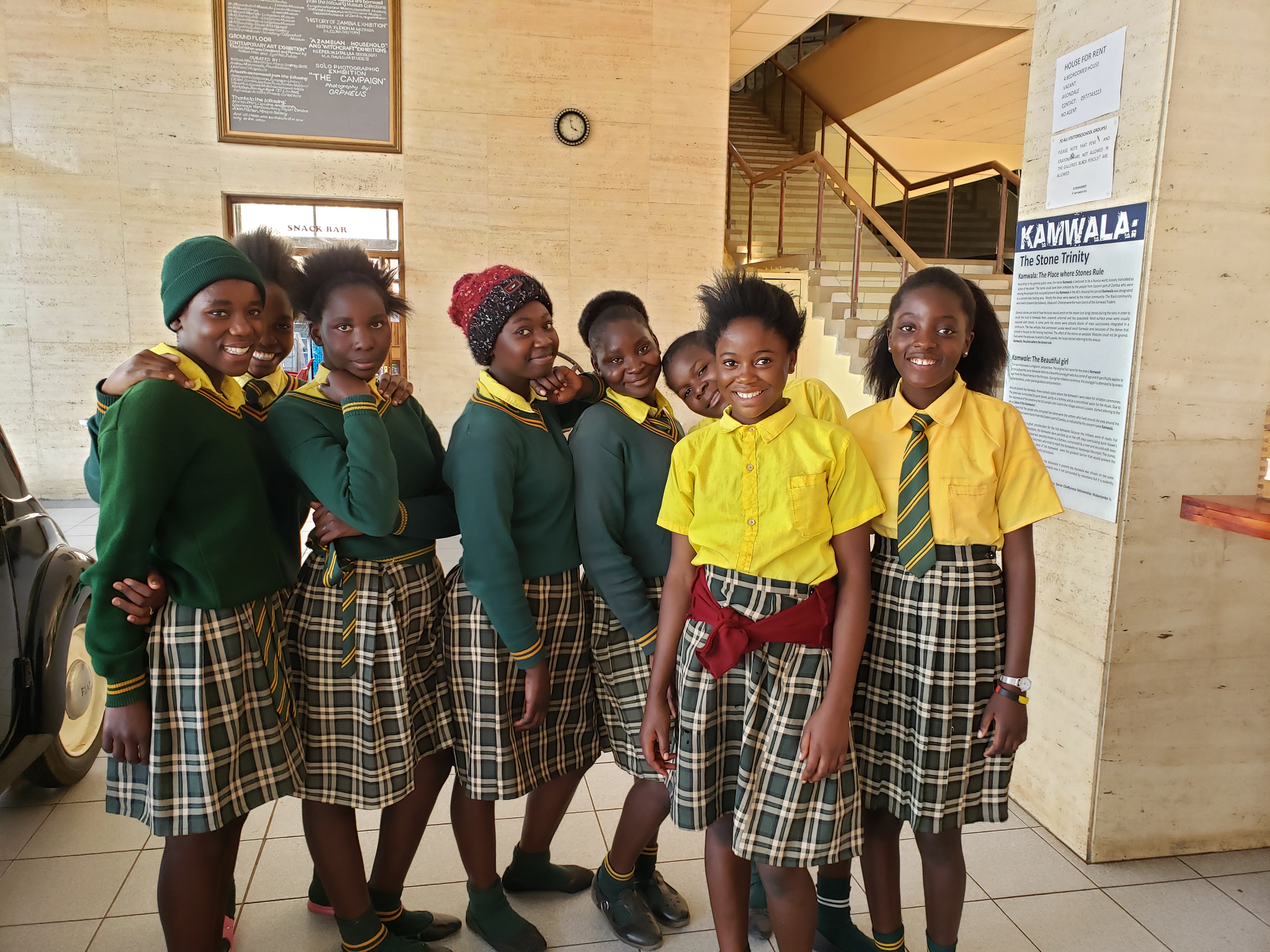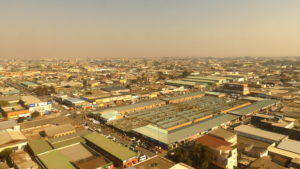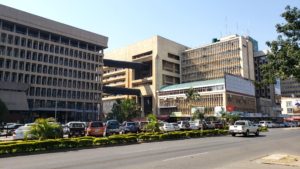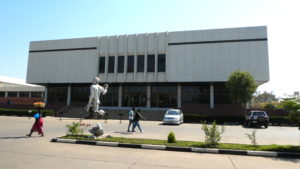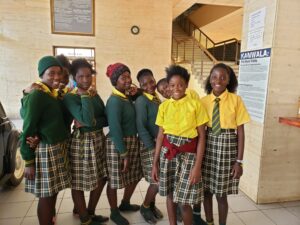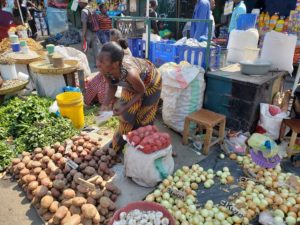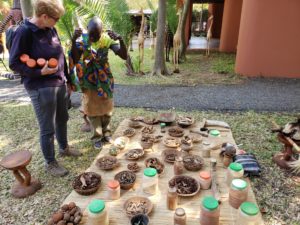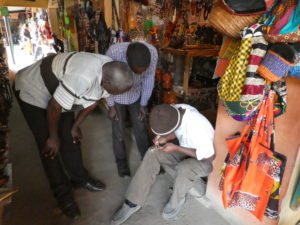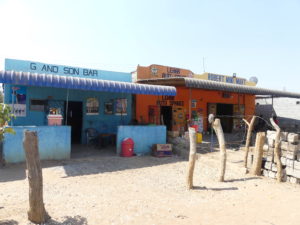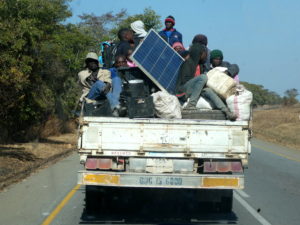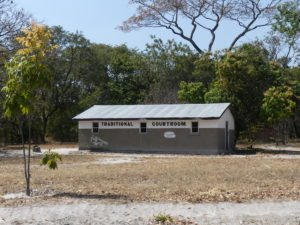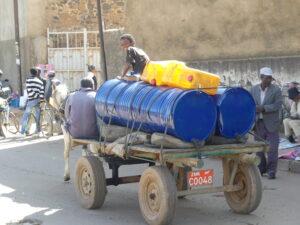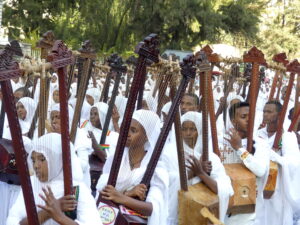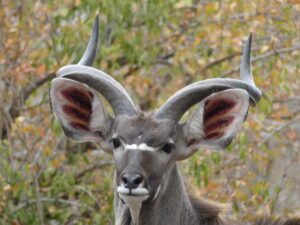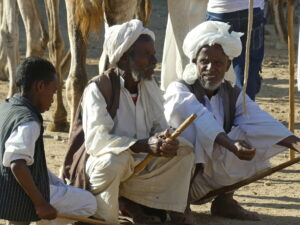In brief: Unfailingly gracious and welcoming to strangers, Zambians – from the capital to the tiniest villages – were among the best of all the peoples we met in Africa.
Lusaka, the capital
We had not spent much time in the capital cities of the countries of Southern Africa, but Lusaka – Zambia’s home for close to 2 million people – was along our route.
So we stayed a few days there in the bustling and very commercial central city, while we caught up on some personal business with especially good internet service.
A few kilometers east of the center, we could find leafy residential districts, but we relished the intensity in the heart of this friendly town after so many weeks in the bush. And we took advantage of southern Africa’s reputedly largest open market, a vast jumble of fresh produce and friendly vendors, pushcarts and minivan buses.
Central Lusaka has a few tall buildings on the principal commercial streets, but mostly it’s a low-lying cityscape.
In our photo, with a technology marketplace filling a large rectangular block in the bottom center of the frame.
A large hospital complex along one of the main streets of central Lusaka. The buildings are typical of the larger buildings in the center, with a 50s and 60s look.
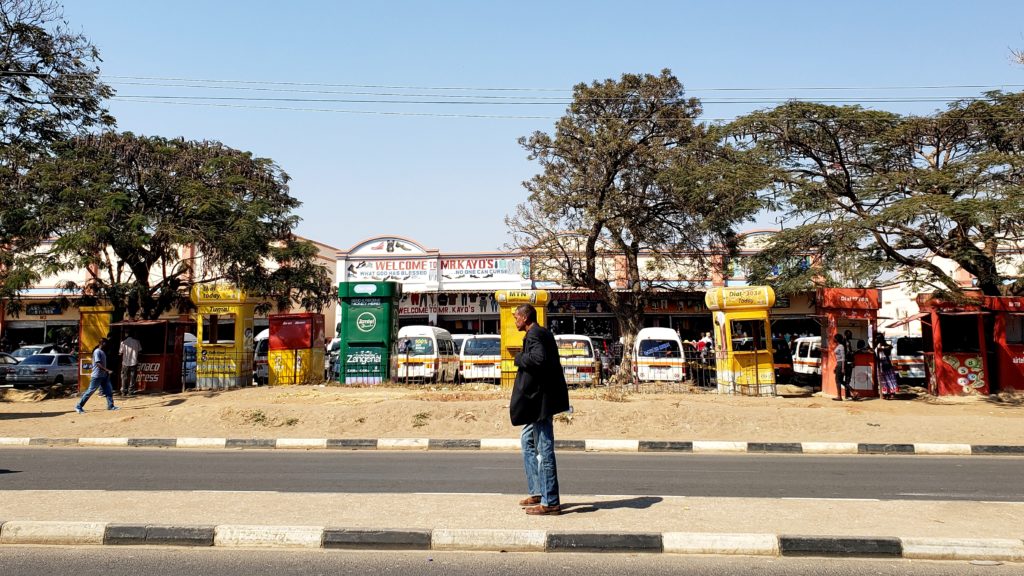
Four new, gleaming shopping malls welcome shoppers within a few kilometers of downtown. This strip mall is not one of them, yet is much more typical of Lusaka. The building contains a variety of other shops, but it centers around Mr. Kayo’s clothing store, with a message aimed perhaps at buyers of its products or just for inspiration: “What God has blessed…no one can curse.” In the parking lot, a host of minivan buses have collected to await shoppers and bring them home. Along the near fence, all the mobile phone operators offer airtime, top-ups and cash sending services. There is little idle space outside of Mr. Kayo’s anyway.
The National History Museum sits on a park like space amid a government complex. It’s not fancy, but it ably tells the story of thousands of years of history and pre-history, with a special emphasis on the troubled years before independence and civil turmoil after. We spent several engaging hours there.
The supersized statue in front of the museum shows a native warrior, whose body is assembled from small pieces of metal bonded together. The woman crossing the parking area shows off a skill of many women here, carrying huge loads atop their heads.
As we were paying admission, eight young schoolgirls – all bright faces and winning smiles – tried to talk their way into the museum for free, as they had little money. When their plea was rejected, we offered to pay the $4.00 in total to cover them. They were so thankful to us that we felt we had found one good way to return the country’s abundant hospitality.
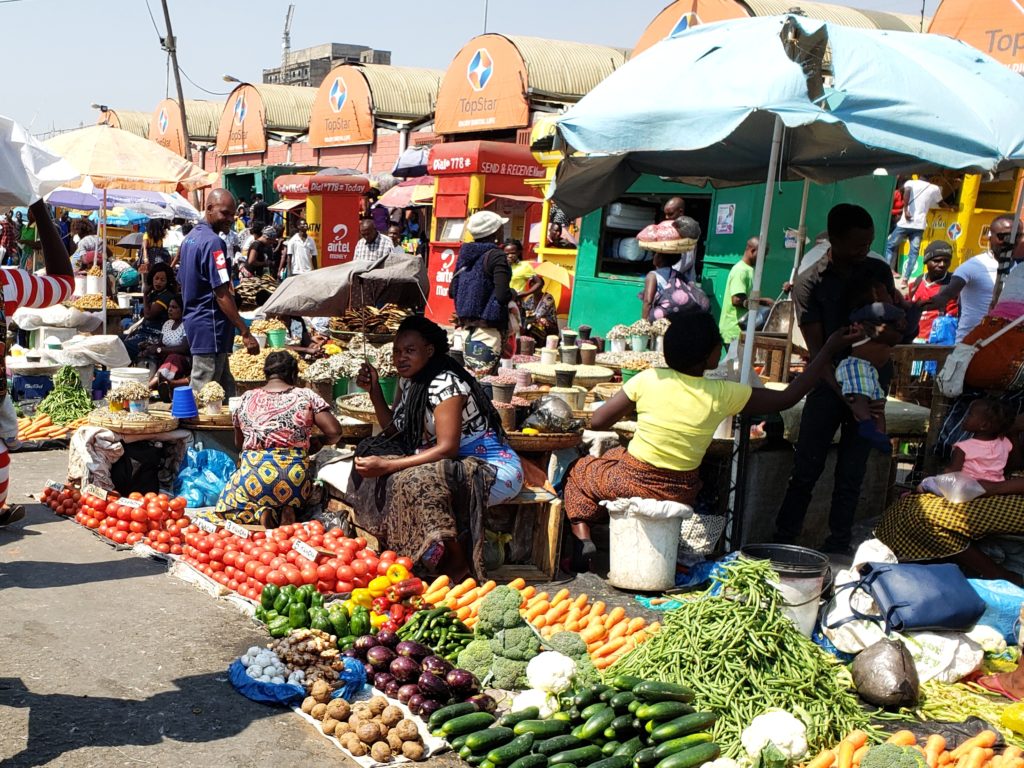
At the Lusaka open air market. We shopped here three times and apparently were memorable enough during our many hours there that several vendors, who are mostly women, recognized us. It’s a long day for them all, 12 hours or so from cold dawn through hot mid-day sun. By the time we left Lusaka we were treated like regular customers. The woman offering that heap of delicious green beans kept shoving extra into our bag – a huge sackful for about $.30 USD. Another, who also acted as a jolly entertainer for neighboring vendors, was selling massive bunches of very tasty local greens for about $.15 each. Perhaps it helped that we were easily recognizable as the only white people (or blond hair) and foreigners in the whole market.
A colorfully dressed produce vendor at the large open air market in Lusaka. Another vendor embraced me with a strong, but friendly, grip as we passed as if to hold on forever, saying something I couldn’t quite make out. When she released me, some nearby vendors explained that she was wanting to marry me. Nancy assured her I was already spoken for.
Zambian people
Zambia was the sixth country we visited across southern Africa on our road trip. By then it was hard to choose which country had the most welcoming people. In Botswana, you couldn’t walk the streets without being greeted heartily. Our travel mates thought Namibians were a bit chillier; we felt they treated us as warmly as any. Zambians – from the big city of Lusaka to the tiniest villages – were among the best, unfailingly gracious, welcoming and eager to host a stranger.
This local medicine man had natural solutions for anything that ailed us, and the zeal to explain each of them.
At craft markets or popular tourist sites, we’ve learned how to balance goodwill and firmness with the relentless souvenir and crafts vendors, both in Africa and in the countries of other continents.
It helps that, generally, we aren’t planning to buy a thing – except for a small spoon to add to the international collection Nancy’s grandmother started. Many countries we visit don’t offer the typical commercial spoons, like those with an image of the Eiffel Tower, say, or Prague’s clock tower. So we must ask local artisans to make us one.
These three men at Victoria Falls shifted from hounding us about shopping their stalls to ensuring that we received a spoon with the name “Zambia” perfectly carved into it.
Meanwhile, with all of us freed from the pressure of selling or buying, we had a long conversation together about the ins and outs of the trade. The main gambit, it seems, is to ensure a potential buyer moves into the space of your stall…the more they see, the more likely they will buy. Oh, and we only bargain down to a reasonably inflated price…a few dollars extra always means much more to them than to us.
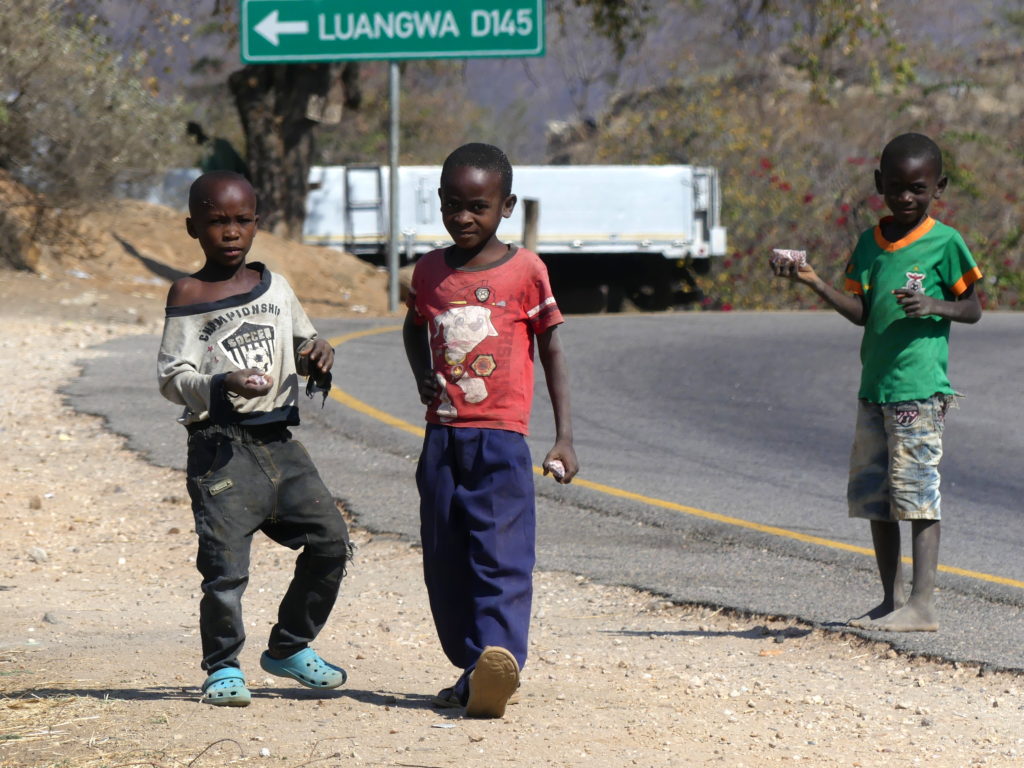
Most of the children we passed in Zambia were thrilled just to watch our loaded car and trailer pass, waving hello and hoping for a wave back. Sometimes, when we stopped, they would throng to the car and ask for “sweeties,” which seemed like the only English they knew. And not because they’re hungry, but because they have learned that many tourists carry palate-pleasing snacks they might hand out. Sadly, too many villages we passed were overflowing with young children. Instead of sweets, we carried small packets of trail mix or peanuts that we could offer when we encountered a small group of kids.
On one Sunday, we stopped to check the car. The three boys in the photo appeared. They knew only a few words beyond their tribal language, but did help us find the right road to South Luangwa national park and, in addition, explained that the gospel music we heard was singing from the nearby church. They are clutching the trail mix we gave them in thanks.
In Zambia, as in other southern African countries, minivans are the principal transportation option, whether out near the villages of the countryside or in the heart of towns – typically stuffed completely with a dozen or more passengers. We’ve been in some and they’re not very pleasant, though they get the job done. Workers often must ride on work trucks instead, like these men we passed on a Zambian highway – along with their household items, bags of charcoal for cooking, spare tires, and in this case a solar panel for electric power back home.
This is one of the buildings we saw at the palace of Chief Chitambo, tribal leader for some 50 thousand villagers near Kasanka reserve. We found the Chief’s palace at the end of a modest dirt road that had been turned into a wider dirt road by Chinese engineering and money for the purpose of transporting mined resources. Outside the low walls sat this courtroom where tribal rules and customs were regularly enforced. A large Welcome sign on the walls implied a casual walkabout within was OK, though no one else was around. So we continued a short distance past the sign onto the grounds and found, behind a grove of trees, a set of low lying white buildings that looked more like colonial-style haciendas than a palace. A groundskeeper, trying to steer us toward a welcome hut, said he was going to tell the Chief himself to come out and greet us. Completely surprised, we demurred, saying we didn’t want to disturb the Chief. But we were really more concerned because we had hardly expected an audience, and so had not brought any kind of customary tribute for him. A formal ceremony of any sort also promised to be a long one, and that would make us too late at our next stop. Yet we regretted our lack of preparation, for the powerful Chief would surely have been an interesting person to meet.
(To enlarge any picture above, click on it. Also, for more pictures from Zambia, CLICK HERE to view the slideshow at the end of the itinerary page.)


